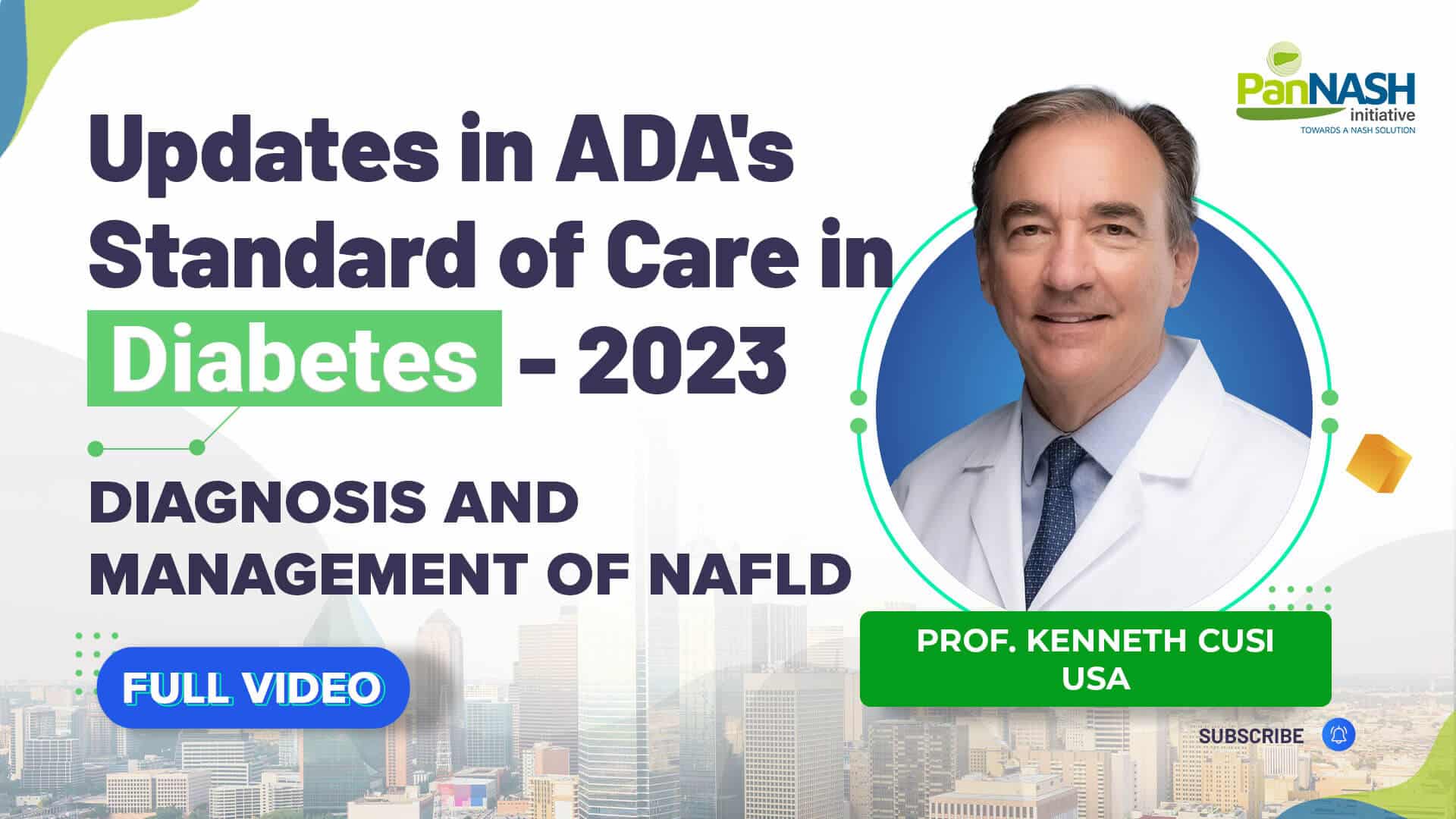Updates in ADA’s 2023 Standard of Care in Diabetes
Introducing Professor Kenneth Cusi
Meet Professor Kenneth Cusi, an eminent expert in the field of medicine. Currently, he is a Professor in the Diabetes Division at the University of Florida. Within the scope of the PanNASH initiative, Professor Cusi is primed to share vital insights into the subject matter.
Today, he will focus on the following:
- Recent updates by the American Diabetes Association
- Standards of medical care for diagnosing and managing NAFLD (Non-Alcoholic Fatty Liver Disease)
Professor Cusi’s expertise and commitment to advancing the field make him an essential voice in this initiative. His upcoming discussion will provide essential guidelines and updates for healthcare professionals and medical students alike, all aimed at improving the understanding and treatment of NAFLD.
OVERVIEW OF New ADA Guidelines 2023: Addressing NAFLD in Diabetes and Prediabetes
Table of Contents
- Introducing Professor Kenneth Cusi
- OVERVIEW OF New ADA Guidelines 2023: Addressing NAFLD in Diabetes and Prediabetes
- Fibrosis Risk Stratification to Prevent Cirrhosis in Diabetes
- Prevalence of Elevated Plasma AST or ALT in Steatosis or Fibrosis in Patients with T2DM Unaware of Having NAFLD
- A global view of the interplay between NAFLD and diabetes
- Interpretation of FIB-4 index for the Diagnosis of Advanced Fibrosis (stage 3-4)
- Fibrosis Risk Stratification to Prevent Cirrhosis in Diabetes
- Diabetes Medications in Patients with Diabetes and Cirrhosis
- Treating Patients with Obesity or T2D for NAFLD to Prevent Cirrhosis
- Pharmacological Approach to the Treatment of Type 2 Diabetes ADA-EASD 2022
- Management Recommendation for the prevention of CVD in Diabetes
- Role of Primary Care Physicians, Endocrinologists, Hepatologists and all Clinicians – Awarenes promotes risk stratification and early referral
Fibrosis Risk Stratification to Prevent Cirrhosis in Diabetes
Updated Screening Guidelines
Dr. Cusi underscores the vital importance of the ADA’s (American Diabetes Association) guidelines in helping healthcare professionals stratify the risks for patients with prediabetes or diabetes.
The first call-to-action, emphasized by the ADA, is to conduct screening and risk stratification for adults with type 2 diabetes or prediabetes. This is particularly crucial for individuals who have obesity and cardiometabolic risk factors. The goal? To identify those who have clinically significant fibrosis, which is the state of being at the highest risk for developing cirrhosis.
Now, how do you proceed with this? According to Dr. Cusi, one reliable tool is the Fibrosis-4 Index (FIB-4). As you know, this equation derives from combining age, ASD, ALT, and platelets. This should be done even if the patient has normal liver enzymes.
Understanding Histological Stages of Fibrosis
Navigating the concept of clinically significant fibrosis can be complex, especially for those who are not hepatologists. So what does clinically significant fibrosis mean? and why that’s an important target of our screening ?
As Dr. Cusi explains, it comprises stages F2, F3, and F4 of fibrosis:
- F0: No fibrosis: So for those who are not hepatologists, in a histopathology analysis of any liver biopsy, you can have no fibrosis
- F1: Mild fibrosis
- F2: Moderate fibrosis
- F3: Advanced fibrosis
- F4: Cirrhosis
Why focus on stages F2 to F4? Those in these stages are not only at high risk of progressing to cirrhosis but also have elevated risks of:
- Hepatocellular carcinoma
- Cardiovascular disease
Leaving these individuals untreated likely guarantees their advancement to cirrhosis. Prof. Cusi highlights that the FIB-4 calculator is widely accessible and is often integrated into electronic medical records, at least in the United States.
Prevalence of Elevated Plasma AST or ALT in Steatosis or Fibrosis in Patients with T2DM Unaware of Having NAFLD
As Doctor Cusi explains, screening practices for patients with type 2 diabetes have evolved significantly. The American Diabetes Association has updated their guidelines, widening the scope from merely those with elevated liver enzymes or steatosis to include all individuals with prediabetes or type 2 diabetes.
Why the Change in Guidelines?
A study where Dr. Cusi participated from the University of Florida highlighted that a shocking 7 out of 10 patients with type 2 diabetes already have steatosis. As you can see you see in the upper left panel where they screened in the study with elastography, 561 patients with type 2 diabetes from outpatient primary care clinics and endocrinology clinics
So, it makes little sense to use an ultrasound, since the vast majority of people with type 2 diabetes already have that steatosis.
Instead, the primary focus should be on assessing the risk of fibrosis. Surprisingly, 1 out of 5 patients with type 2 diabetes has fibrosis.
Relying solely on liver enzymes for diagnosis would result in underdiagnosis, capturing only a small fraction of patients. The study found that 15% of patients had moderate to advanced fibrosis. These are staggering numbers.
More recent MR elastography studies revealed that about 7% already have cirrhosis. Thus, if clinicians were to rely solely on liver enzymes above 40 or even above 30, a majority of cases would go undetected.
This emphasizes the urgent need for a broadened scope in screening, aiming to catch those at risk before it’s too late. Doctor Cusi underscores that elevated liver enzymes alone are an inadequate marker for disease prevalence and severity in this patient demographic.
A global view of the interplay between NAFLD and diabetes
Building upon previous research, Professor Kenneth Cusi delves into the topic from an international perspective. His global viewpoint helps us understand that NAFLD (Non-Alcoholic Fatty Liver Disease) is not confined to any particular region but is intricately linked with the prevalence of type 2 diabetes across the world.
Global Prevalence of Fibrosis in T2D
Numerous studies corroborate that fibrosis is present in roughly 12 to 20% of people with type 2 diabetes, depending on the setting.
In a collaborative study with Professor Stefan from Germany, countries or regions depicted in darker red on a plot had higher rates of diabetes and, correspondingly, higher rates of steatosis and NAFLD.
The geographical distribution of type 2 diabetes aligns significantly with the prevalence of liver fibrosis. Regions with a higher rate of diabetes are also likely to exhibit higher incidences of liver fibrosis.
Professor Cusi emphasizes that this isn’t just a local or national issue. It is a global concern, reflecting how intimately type 2 diabetes and liver conditions like NAFLD are interconnected across borders. It’s an international call to arms for the medical community to acknowledge and act upon this interplay.
Interpretation of FIB-4 index for the Diagnosis of Advanced Fibrosis (stage 3-4)
Dr. Kenneth Cusi emphasizes the FIB-4 index as an essential tool for healthcare professionals, particularly for those who may not specialize in hepatology. This tool, in reality, is aiming to capture, with recent studies showing good specificity, stages three and four.
According to Dr. Cusi, even if you’re not a hepatologist, you can easily access this information. Simply open your web browser on your phone and type “FIB-4 calculator.” It will guide you to an equation. For example, a 53-year-old patient with AST levels at 51, ALT levels at 65, and a platelet count of 151,000 will get a FIB-4 score of 2.2.
Decoding FIB-4 Scores
A FIB-4 score below 1.3 generally suggests a low risk of advanced fibrosis, encompassing stages 3 and 4. Conversely, a score above 2.67 indicates a high probability of advanced fibrosis.
Navigating the Indeterminate Zone
Dr. Cusi mentions that approximately one-third of patients with type 2 diabetes will find themselves with a FIB-4 score that falls into an indeterminate range. These patients may not definitively have advanced fibrosis, but they are highly likely to be struggling with advanced liver disease and Non-Alcoholic Steatohepatitis (NASH).
Why FIB-4 is Crucial for Type 2 Diabetic Patients
This tool is particularly relevant for type 2 diabetic patients, especially those who are obese, as they are at an elevated risk for advanced liver issues.
Dr. Cusi emphasizes that the FIB-4 index should not be underestimated or overlooked. It’s a crucial component of the diagnostic toolkit for clinicians aiming to manage liver fibrosis risks in their type 2 diabetic patient population effectively.
Fibrosis Risk Stratification to Prevent Cirrhosis in Diabetes
Additional Screening Guidelines
Dr. Kenneth Cusi underscores that for those dealing with either prediabetes or type 2 diabetes and who also present with consistently elevated liver enzymes, additional investigations may be required. Specifically, if liver enzymes remain elevated for a period of six months or more and the FIB-4 index suggests a low risk of fibrosis, clinicians should explore other potential causes of liver disease
When to Consult a Specialist
Furthermore, Dr. Cusi emphasizes the importance of knowing when it’s time to consult a hepatology specialist. Adults with prediabetes or type 2 diabetes and who have an indeterminate or high FIB-4 score should undergo further risk assessment.
Additional Diagnostic Methods
The American Diabetes Association recommends additional tests for these patients, which include liver stiffness measurements by:
- Vibration
- transient control
- transient elastography
- blood markers like the Enhanced Liver Fibrosis (ELF) test, which is widely available in many countries.
Depending on your setting, the primary care doctor, the endocrinologist can do that before referring the patient to the hepatologist. In other cases, endocrinologists or primary care doctors or other specialties may refer the hepatologist for this additional workup.
American Diabetes Association Guidelines 2023
For 2023, the American Diabetes Association has updated its guidelines, following fairly well-established algorithms by the American Association of Clinical Endocrinologists and by the Liver societies. The initial test remains the FIB-4 index.
Caveats of FIB-4
Dr. Cusi mentions some important limitations of the FIB-4 index:
- The index hasn’t been thoroughly validated for individuals under 35 years old and is not suitable for youngsters or teenagers.So given that the age is at a very low, it can give you a falsely low value.
- Age can distort the FIB-4 score in older individuals, specifically those over 65. Higher cutoff values may need to be considered for this demographic.
- While the FIB-4 index shows strong specificity, its sensitivity is low. This indicates that it might not capture all individuals at risk, especially those in the “gray zone.”
Further Diagnostic Steps
If a patient falls into this gray or indeterminate area, Dr. Cusi advises repeating either the transient elastography or the ELF test. For those at high risk, a direct referral to a hepatologist is strongly recommended.
By adhering to these newly updated guidelines and incorporating these diagnostic tools, healthcare professionals can better manage the risks associated with liver fibrosis in their type 2 diabetic patients.
Lifestyle Changes
The primary recommendation for people with prediabetes or type 2 diabetes, especially those who are overweight or obese and have cardiovascular risk factors, is to adopt lifestyle changes. These should be aimed at weight loss and increased physical activity, ideally within structured programs that have shown effectiveness.
Pharmacological Interventions
The second aspect, which is more important for many patients with severe obesity, GLP-1 receptor agonists are recommended. These have shown benefits in cases with presumable NASH.
When it comes to managing type 2 diabetes specifically, medications such as pioglitazone or GLP-1 receptor agonists, including liraglutide and semaglutide, are viable options. These drugs have proven to be effective in weight loss and are particularly well-researched within the context of NASH.
Additionally, it’s worth emphasizing that when referring to “diabetes,” the focus here is on type 2 diabetes. Drugs like pioglitazone and GLP-1 receptor agonists are not just options but are approved treatments for type 2 diabetes and have shown effectiveness in weight loss.
Of particular note are two GLP-1 receptor agonists—liraglutide and semaglutide—which have undergone more rigorous scrutiny in the study of NASH. These medications have been evaluated through paired biopsy randomized controlled trials, further supporting their recommended use.
Pioglitazone Data Insights
Dr. Cusi briefly highlights data on pioglitazone, a thiazolidinedione with a predominantly PPAR-gamma action, emphasizing its long-term study that showed a reversal of steatohepatitis in one-third to two-thirds of patients, depending on the histological definition.
In addition to its PPAR-gamma action, some research also suggests that pioglitazone might have a PPAR-alpha effect. The initial study where participated Dr Cusi on pioglitazone was conducted about 15 years ago, focusing on individuals with either prediabetes or type 2 diabetes.
Subsequent studies extended the scope to include people without diabetes and culminated in a long-term research project with up to three years of follow-up. This long-term study further confirmed the drug’s effectiveness, showing fairly consistent results in reversing steatohepatitis.
Moreover, there have been additional studies that investigated the combined effects of pioglitazone and vitamin E. While these studies yielded mixed results, another study originating from Asia also supported the positive effects of pioglitazone in treating this liver condition.
Diabetes Medications in Patients with Diabetes and Cirrhosis
In a comprehensive review co-authored by Dr. Cusi and Dr. Castera from Paris, France, the pair examined the range of medications available for managing diabetes. The review elucidates how each drug operates to lower glucose levels in diabetic patients. But unfortunately, Dr. Cusi points out that only pioglitazone and GLP-1 receptor agonists have been rigorously studied using paired biopsies in randomized controlled trials, and have shown beneficial outcomes in this context.
Dr. Cusi further notes that while SGLT2 inhibitors and insulin have shown promise in reducing steatosis, these medications are still pending further histological studies to validate their efficacy.
Additionally, Dr. Cusi advises caution in managing diabetes for those with decompensated cirrhosis. He underscores that insulin is the preferred therapeutic agent in such cases but should be used with care.
The reason for this caution is that patients with cirrhosis are more susceptible to hypoglycemia, and therefore it’s generally recommended to avoid non-insulin agents in these particular patients.
Treating Patients with Obesity or T2D for NAFLD to Prevent Cirrhosis
Dr. Cusi strongly emphasizes the importance of early risk stratification in treating patients with obesity or Type 2 Diabetes (T2D) to prevent the progression to cirrhosis. He reiterates that our current capabilities to reverse cirrhosis are severely limited.
Dr. Cusi also underscores that lifestyle interventions and bariatric surgery are beneficial interventions at any stage of the disease. He mentions that he will share the most recent recommendations by the American Diabetes Association (ADA) on this topic shortly.
In terms of pharmacological interventions, Dr. Cusi lays out the dosing recommendations for GLP-1 receptor agonists like liraglutide and semaglutide, specifying doses both for obesity and for diabetes.
He also brings attention to pioglitazone, describing it as a very cost-effective, generic drug option. However, he cautions that pioglitazone does come with some risks, including potential weight gain, and it is crucial for clinicians to weigh these factors when considering it as a treatment option for their patients.
Pharmacological Approach to the Treatment of Type 2 Diabetes ADA-EASD 2022
Dr. Cusi emphasizes the recent guidelines jointly released by the American Diabetes Association (ADA) and the European Association for the Study of Diabetes (EASD) in 2022. He points out that these guidelines specifically recommend the use of diabetes medications with demonstrated efficacy in treating Non-Alcoholic Steatohepatitis (NASH). Specifically, the guidelines endorse the use of pioglitazone and GLP-1 receptor agonists for this purpose.
Dr. Cusi expresses hope that these medications will soon be included in the comprehensive treatment table that he had earlier presented, thereby reinforcing their importance in the management strategy for patients with Type 2 Diabetes who are also at risk for or suffering from NASH.
Management Recommendation for the prevention of CVD in Diabetes
In conclusion, Dr. Cusi underscores the critical relationship between Non-Alcoholic Steatohepatitis (NASH) and elevated cardiovascular disease (CVD) risk in people with diabetes. He advises healthcare providers to continue prescribing statins as recommended by the American Diabetes Association (ADA).
Dr. Cusi cautions against the common practice in primary care of discontinuing statins due to elevated liver enzymes. According to him, statins are generally safe and beneficial for people with diabetes and compensated cirrhosis. However, he recommends exercising caution with statin therapy as patients progress towards more advanced stages of liver disease. Statins should probably be discontinued in the final stages of advanced liver cirrhosis.
Lastly, Dr. Cusi discusses the role of bariatric or metabolic surgery in managing these complex conditions. The ADA deems this surgery appropriate when performed in experienced centers, given its efficacy in reducing cardiovascular risks and potentially reversing NASH. However, the procedure should be used judiciously in people with compensated cirrhosis. It is not advisable for those with decompensated cirrhosis, as it has been shown to increase morbidity and mortality in this specific population.
Role of Primary Care Physicians, Endocrinologists, Hepatologists and all Clinicians – Awarenes promotes risk stratification and early referral
In his closing remarks, Dr. Cusi emphasizes the importance of a multi-disciplinary approach in managing patients with Non-Alcoholic Fatty Liver Disease (NAFLD), obesity, and diabetes. He extends his gratitude to all healthcare providers—primary care physicians, endocrinologists, cardiologists, hepatologists, and gastroenterologists—for their time and effort.
Dr. Cusi advocates for a united front where NAFLD is placed at the center of patient care. He acknowledges the far-reaching implications of this disease, not only in liver health but also in broader issues such as obesity, diabetes, and cardiovascular disease. Dr. Cusi closes by underlining the critical role clinicians play in altering the course of these conditions, ultimately preventing the severe outcomes like cirrhosis, hepatocellular carcinoma, and cardiovascular complications.
He thanks all healthcare providers for their time and encourages continued collaborative efforts to change the trajectory of these life-altering diseases.








